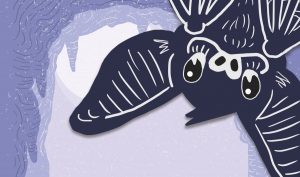
Bats make up about 25 percent of mammals on the planet and are found in almost every corner of the world. The bat, the only flying mammal, has been a symbol of the dark, the night and a staple around the Chautauqua night skies for years. Between having their heads bitten off by Ozzy Osbourne to striking fear into the hearts of Gotham’s criminals, a sense of dread has long been associated with bats — much to their own detriment.
According to Bat Conservation International, a number of factors have led to large decreases in bat populations in recent decades. Prior to 2000, the largest mortality factor for bats worldwide and nationally was human activity. Since then, large wind turbines and white-nose syndrome (WNS) have dwarfed these figures in the United States.
WNS was first detected in the United States in a cave near Albany, New York, in 2006, most likely transferred by humans from caves in Europe. Within years, the Albany cave’s population was virtually depleted. The fungal disease thrives in cold, dark, damp environments — making hibernating bats in caves perfect targets.
Of the 1,300 species of bats worldwide, nine are found in New York.
Jonathan Townsend, adjunct professor at Jamestown Community College and board member at Greystone Nature Preserve in Fredonia, has been interested in bats since he was a child.
“I’ve always been interested in bats and learning more about them any chance I get,” Townsend said. “The more I learn about bats, the more interested I am.”
Townsend’s interest in bats is what drove him to earn degrees in environmental science and biology at SUNY Fredonia. Townsend’s first bat research during his undergraduate studies took place at the Institution around 2005, when local bat populations were around 5,000. By the time Townsend began conducting research for his graduate studies in 2012, WNS had made its way through the state and Institution.
“It’s tragic, it’s absolutely tragic,” Townsend said. “Every little brown bat can eat 1,000 mosquitos in an hour. They provide more than $25 billion to the agriculture industry (annually) in the U.S. alone. They’re extremely important, but they have a serious PR problem.”
While performing emergence counts at the Gleason Hotel, Townsend said his team would count as many as 400 bats coming out of the building in one night. Doing another count at the hotel after the emergence of WNS, Townsend said there were none.
Townsend said WNS attacks the bats during their hibernation cycle.
“(The fungus) opens up these micro-fissures in their skin, sort of like ringworm,” he said. “They either die in hibernation or they wake up hungry and try to fly out of the cave to get food, and either can’t fly out or they fly out and die very quickly.”
This disease has decimated upward of 90 percent of the bat population nationally, and there is another growing killer of bats — wind turbines. Estimates for bats killed by coming into contact with the machines range from tens of thousands to more than a million.
There are many who think that wind energy is part of a larger solution to human reliance on fossil fuels, Townsend said, but that might be detrimental to bat and bird populations. Many studies, Townsend said, support the idea that the turbines actually attract the bats, who often settle on the tallest trees or structures they find on their migratory paths.
Townsend said that by reducing the ways these turbines operate slightly, bat mortality rates can drop by as much as 70 to 80 percent. However, he said wind energy producers are reluctant to make these changes due to loss of production.
“You lower one turbine’s power and put up seven more around it to make up for energy production — you’re not really helping the issue.” Townsend said.
Townsend said he is by no means opposed to wind energy, just the method of production that is so detrimental to bat and bird species. He said there are less harmful strategies, such as solar panels on buildings, that do not interrupt migratory paths or cause these species harm.
With still so much left to learn about bats, even for researchers, Townsend said it’s important to spread education and awareness to reduce the bad publicity that has surrounded bats for so long. Townsend said bats still need places to live, such as bat houses.
One project he is currently working on with the Chautauqua administration is the installation of a bat mansion, or bat condo, on the grounds. While a typical three- to four-chamber bat house can hold around 250 bats, this type of modular design could house thousands of bats. Townsend is working with the Institution to pick an appropriate place for the installation before he starts raising funds and awareness for the project.
Alongside other organizations such as the Roger Tory Peterson Institute and the Audubon Community Nature Center, Townsend there is a collective to ensure something is done to help bats afflicted with WNS.
“Hope is not lost for (combating WNS),” Townsend said. “Even if it’s just 1 percent, it’s that 1 percent that’s going to repopulate the species. They are around. They can come back. We’ve just got to give them space and that place to raise their pups in.”
Carl Herzog isn’t so sure. He works in the Albany office for the New York State Department of Environmental Conservation, primarily in wildlife diversity and protecting and studying rare animals.
Herzog said upward of 95 percent of the work he does these days concerns bats. Although there is still hope for preventing the further spread of WNS across the country, he thinks there’s little to be done for prevention in the state.
“It’s really too late for that,” Herzog said. “In general, there’s nothing you can do about it in New York. It’s already everywhere.”
Four of the nine species of bats in New York have been severely affected by WNS, Herzog said. Once the most populous species in the state, little brown bats have declined by about 90 percent, Herzog said. There were, at one time, around 1.5 million of these bats in New York alone.
The tri-colored bat was rare in New York before WNS even arrived. The species is virtually gone, from a practical perspective, Herzog said, with less than 1 percent remaining. Indiana and northern long-eared bats were also both on the endangered species before WNS arrived in the state. Both of those species have been eradicated across the state except for one colony of each, which Herzog said is not an ideal situation considering how the disease spreads.
The DEC operates primarily as a regulatory agency, protecting the remaining animals in species that are under legal protections.
“The tri-colored and little brown bats are both being considered for federal endangered species protection, as well,” Herzog said. “When that happens, we will take steps to protect them through the regulatory processes.”
Herzog said it’s very hard to predict a timeframe for when, or if, this will occur on a federal level. Most efforts involve assisting research to understand the disease and keeping track of how the remaining animals are doing.
European bats have dealt with WNS for hundreds of years. Over time, they have adapted and learned how to cope with the disease.
Severity of afflictions locally has leveled off after the initial decimation across the region when the disease arrived in the late 2000s, Herzog said. He said he hopes that this leveling-off can turn into a recovery, but that there’s not enough evidence yet to say this is the case.
“That’s our hope for (these) species and for others,” Herzog said. “Wildlife diseases do occasionally cause specific species to go extinct, but it’s rarely the case. If the disease kills off the hosts it’s living on, it means the pathogen dies with it.”
Christina Kocer works for the United States Fish and Wildlife Service and is WNS regional coordinator for the northeast region. Working with the Fish and Wildlife Service since 2011, Kocer said she has been dealing with WNS since day one.
“Because it started here, we are the lead region,” Kocer said. “(This region) has been hit the hardest only because we’ve had it the longest.”
Although there have been signs of stabilization in certain species, including little brown bats, it’s not the case at every site, Kocer said. She said the fact that no species have been lost at this point is good news.
“If you asked me 10 years ago when we first saw the disease and the impact it was having, I would have been concerned with having any bats at this point,” Kocer said. “We haven’t lost any species yet. We’re doing everything we can to not let that happen”
While there are parallels to other wildlife diseases, Kocer said WNS is really unprecedented in how quick and devastating it’s been to bat populations. Finding the best strategies for recovery, protection and possible treatment is extremely important, Kocer said. She said organizations such as the Fish and Wildlife Service are looking for any tool possible.
“There’s not going to be a silver-bullet solution,” Kocer said. “There’s not likely to be an actual cure for this problem, but we might be able to help things out and make things better, having a chance for more bats to survive.”
Sandra Emke is a graduate student at SUNY Fredonia, working on her thesis in biology after getting her bachelor’s degree in environmental science. Her research focus is bats and their ecology. Also assistant director for Greystone Nature Preserve, Emke has been conducting emergence counts, bat house checks and acoustic surveys for a few years now.
Acoustic surveys involve detecting bat calls with an ultrasonic microphone attached to an iPad, which deciphers the species and gender of the bats being detected to get a rough estimate of the number of bats in the area. Each call has its own frequency and spectrum, though noise interferences do produce false calls occasionally.
This is the third year she has conducted these surveys at the Institution, Emke said, and all of the surveying techniques she uses help understand activity levels in a given area.
“If we know activity levels, we can tell roughly how high or how low our bat populations are compared to historical date we have,” Emke said. “In order to put proper conservation methods in, you have to know where population levels stand before you put conservation methods into action.”
Through 16 surveys over the summer of 2017, Emke picked up 3,860 calls before “noise calls,” or false calls, were removed from the figure. This year, without excluding noise calls, 456 calls have been detected. Emke said it is too early to say the numbers have dropped because the calls become more rampant near the end of the surveying period. Although there were only 80 calls picked up on July 25, just five days later Emke recorded 171 on July 30.
Caroline Van Kirk Bissell grew up in Chautauqua and has been coming to the Institution since 1946. She started giving Bat Chats for the Bird, Tree & Garden Club in 2000 after the previous naturalist retired the year before. Bissell spent that winter reading through 30 bat books and tries to synthesize it all down into a hour-long lecture, something she said is a challenge some days.
“There’s always been a faction in the BTG that loved bats,” Bissell said. “My mother was one. She helped start funding in the late ’80s and early ’90s to find out just how many we had.”
Bissell said at one point, there were around 10,000 bats living on the grounds, in attics, bat houses and little crevices of homes they could wedge themselves into.
“Growing up as a kid, we just took them for granted,” Bissell said. “You’d look up at a big street light, and there’d be bugs swarming and bats would just be dive-bombing the bugs around these streetlights. They would fly by and maybe they would graze your hair. Growing up, we just took it in stride.”
Bissell said it’s going to take a long time for bat populations to recover, though some might not.
“I would love it if the bats came back in numbers,” Bissell said. “We’re seeing a few more big brown (bats). I have hope for it, but there’s a caveat there.”
Researchers are studying these local bat species closely as select populations slowly begin to recover in the state, hoping information can be used at the forefront of the effort to stop WNS in its tracks.




